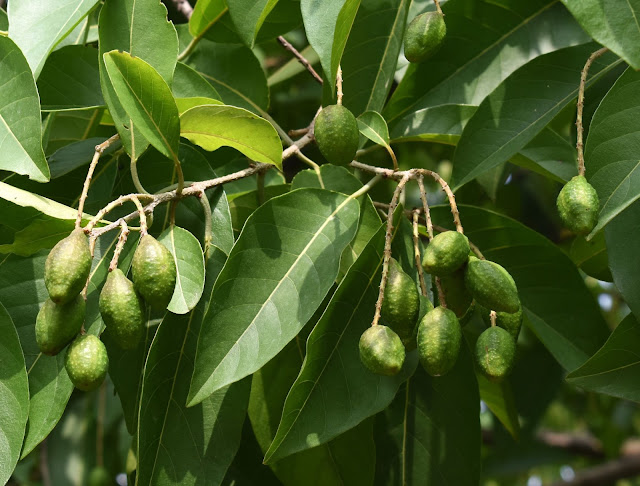
Jyotishmati, botanically known as Celastrus paniculatus (family- Celastraceae), is a large and woody deciduous twining shrub. It is variously used in many traditional medicinal systems and Ayurveda for managing pain and local inflammation.
|
NAMES IN
DIFFERENT LANGUAGES |
|
English: Intellect plant, Black oil plant, Staff
tree, Climbing staff tree Hindi: Malkangni, Malkunki, Sankhu Sanskrit: Jyotishmati,
Alavana, Maalkaanguni, Kanguni, Kangunika, Katumbhi, Kaakaandaki, Katuveeka,
Paravatpadi, Svarnalatikaa, Vanhiruchi Pahari: Sankheeru Bengali: Kijri, Kondgaidh, Lataphataki, Malkangni,
Sankhu Malyalam: Ceruppunna, Ceruppunnari, Palulavum, Uzhinja,
Valulavum, Valuzhavam Marathi: Dhimarbel, Kangani,
Malkanguni, Pigavi Tamil: Adibaricham, Kagodagi,
Kalambam, Kaligam, Kirumikkundram, Kungiligam, Manjakodi, Gundumida,
Manirteega, Peddamaveru, Palleru, Vaaluluvai Urdu: Malkangni |

DISTRIBUTION
Jyotishmati is native to Indian Sub-continent including India, Bangladesh, Cambodia, South-Central and Southeast China, Jawa, Laos, Lesser Sunda Island, Malaya, Myanmar, Nepal, Philippines, Sri Lanka, Sumatera, Taiwan, Thailand and Vietnam growing up to 2000m above mean sea level on the forest slopes.
MORPHOLOGY
Jyotishmati is a large deciduous twining shrub. The stem bark is pale brown, rough, cracked and exfoliates into small scales. The branchlets have prominent elliptic lenticels. Leaves are simple with elliptic, oblong, rectangular, ovate, or obovate leaf blades which are 5-10 × 2.5-5 cm in size. The leaf base is cuneate, margin serrate and apex mucronate to acuminate. Secondary veins are in 5-7 pairs. Inflorescence is a terminal thyrse, 5-10 cm long. Flowers are minute, greenish, 5-merous and dioecious. Sepals are free, imbricate and semiorbicular. Petals are oblong to obovate-rectangular. Stamens are inserted on the margin of the disk. The ovary is globose. Fruit is a globose, 3-6-seeded capsule measuring 1-1.3 cm in diameter, yellow in colour when ripe. Seeds are elliptic, 3.5-5.5 × 2-5 mm in size and are covered with orange-red aril.
CHEMICAL
CONSTITUENTS
MEDICINAL USES
1. Folk
Medicinal Uses
Jyotishmati fruits and seeds are widely used
in folk medicine for treating rheumatism, bleeding haemorrhoids (piles), diarrhoea
and leprosy. The seed oil is also used for hair growth.
2. Improves Memory and Prevents Dementia
Jyotishmati is reported to improve memory,
concentration, alertness, and cognitive functions. Various studies using
fruits, seeds and oil in experimental animals have shown that it slows down the
progress of dementia by preventing neural cell damage through its antioxidant
properties. The exact mechanism of action on neurons is still unknown.
3. Hypolipidemic Effect
Recent experimental studies on animal models have
reported that oral administration of methanolic seed extract of Jyotishmati reduces
the plasma total cholesterol, triglycerides and LDL cholesterol. The atherogenic index and liver weight of treated animals decreased, while the HDL cholesterol
level substantially increased as compared to a control group.
4. Anti-Inflammatory Properties
Jyotishmati seeds possess significant anti-inflammatory
and anti-nociceptive (pain-reducing) properties and are useful in
managing joint inflammation and pain when applied externally. Some healers also
recommend it for osteoarthritis.
5. Sedation and Anti-Convulsion Activity
Experimental studies on animal models have
shown Jyotishmati to possess sedative and anti-convulsion activity.
6. Anti-Fungal Activity
Jyotishmati
seed oil has shown anti-fungal activity against various pathogenic fungi.
7. Anti-Bacterial Activity
Aqueous extract and oil of Jyotishmati are
reported to exhibit potent anti-bacterial activity against Bacillus
subtilis, Corynebacterium diphtheriae, Salmonella typhi, Escherichia coli,
Proteus vulgaris, Bacillus cereus, Klebsiella pneumoniae, etc.
8. Wound Healing Property
The triterpene compounds present in the leaves of
Jyotishmati are reported to have good wound-healing properties.
9. As Aphrodisiac
The practitioners of Unani medicine consider
seeds of Jyotishmati as potent aphrodisiacs.
10. Useful in Insomnia
Jyotishmati seeds and oil are considered to have anti-stress and
calming properties and are thus useful in insomnia.
TOXICITY
Toxicity studies with Celastrus paniculatus have shown no sign of toxicity in many experimental animals. It is reported to be safe up to a dose level of 2000 mg/kg in various experiments (1). Another study with a single administered dose of 5,000 mg/kg body weight was also reported to be nontoxic (2). It is reported to have antispermatogenic action in rats (3). Readers are advised not to use this plant without consulting registered medical practitioners.
REFERENCES
Akbar, S
(2020). Handbook of 200 Medicinal Plants: A Comprehensive Review of
Their Traditional Medical Uses and Scientific Justifications. Springer.
Bhanumathy, M; Harish, MS;
Shivaprasad, HN and Sushma, G. (2010). Nootropic activity of Celastrus
paniculatus seed. Pharmaceutical Biology 48(3): 324-327.
Bidwai, PP; Wangoo, D and Bhullar, N. (1990). Antispermatogenic
action of Celastrus paniculatus seed extract in rat with reversible
changes in the liver. J Ethnopharmacol. 28:293–303.
Kulkarni, YA; Agarwal, S and
Garud, MS. (2015) Effect of Jyotishmati (Celastrus paniculatus) seeds in
animal models of pain and inflammation. J Ayurveda Integr Med 15 (6):82-88.
Kumar, MH and Gupta, YK. (2002). Antioxidant
property of Celastrus paniculatus Wild.: A possible mechanism in enhancing
cognition. Phytomedicine 9(4):302-11.
Mishra, B; John, E;
Joy, K; Badmanaban, R and Aleesha, R. (2020). Toxicity profile of Celastrus
paniculatus seeds: A preclinical study. Asian J Pharm Clin Res 13(
7): 115-118
Patil, RH; Prakash, K and
Maheshwari, VL. (2010). Hypolipidemic Effect of Celastrus paniculatus in
Experimentally Induced Hypercholesterolemic Wistar Rats. Ind J Clin Biochem.
25: 405–410.
Sharma, GN; Kaur, H; Shrivastava, B and Arora, SC. (2020). A
review from historical to current-Celastrus paniculatus. Int. J.
Pharm. Pharm. Sci. 12(8): 15-20.
Shen, Y; Chen, B-L; Zhang, Q-X; Zheng, Y and Fu, Q. (2019). Traditional uses,
secondary metabolites, and pharmacology of Celastrus species - A review.
J. Ethnopharmacology. 241. 111934. 10.1016/j.jep.2019.111934.






.JPG)
.JPG)
1.JPG)










.JPG)
.JPG)
.JPG)

.JPG)

.JPG)
